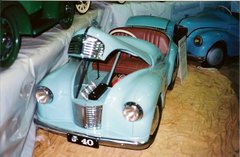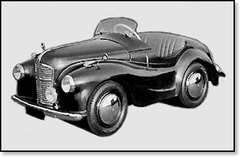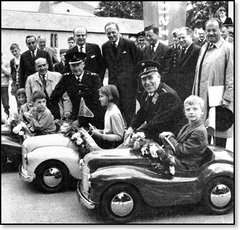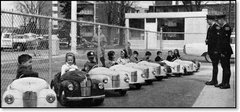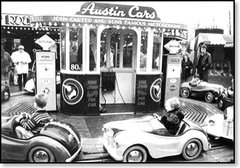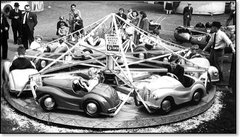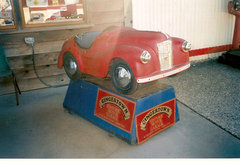The Beginning
It was in 1943 that Parliament passed an act that recognised that many miners were been struck down with what the miners called "The Dust" (pneumoconiosis’s). The Government decided to encourage employers to give ex-miners employment. Leonard Lords had taken this to heart and decided that those (in this case South Wales miners) who had been cut down by this respiratory condition could still earn a wage. It was stated that in 1945 there were over 5,000 miners suffering from this disease. The plan was that they would build a Toy Pedal Car based on the current models. To keep the cost down, it would use metal off-cuts.
It was Leonard Lord, Chairman of the Austin Motor
Co who in April
1946 summoned Rod Phillips who was an Artist attached with the Post
War Planning whose brief was to look into the future of how the
factory would look in the Post War period. He was joined by Jim
Blaikie who had join him after serving in the war, (it was a
government directive that any person who was employed before the
war, his employer would have to offer them their old job back on
returning to civilian life.
Both Rod and Jim had no experience of body design and the tooling
needed. This is where a third member Alf Ash joined the team who
had the expertise.
The team were given a disused workshop in South Works in which to
set up a design office and experimental build. So it was down to
looking at the specification.
a) Suitable for children in
the age range four to nine.
b) Most be able to have room in the front for a smaller brother or
sister.
c) Bonnet and boot to open.
d) Lights that work along with a dummy engine
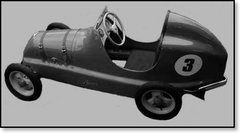 Austin Pedal Cars
Austin Pedal Cars
The Austin J40 and the Austin Pathfinder is one of the most collectible pedal cars found in Australia(and one of the more expensive types) The information and pictures were obtained from the Austin Memories web site, the site that is all about Austin & Longbridge..)
(Please note The pictures are the copyright of the British Motor Industry Heritage Trust and the information given in the article was obtained from David Whyley.)
Production Stage
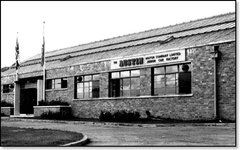 Although the
original idea was to use up scrap sheet metal from
Longbridge, this was only possible for small parts, the larger
panels would be produced from fresh steel strip. The Government
were willing to pay for a new factory, so it was decided to build
the factory at Bargoed in Wales. To set the factory up second hand
presses a total of nine were send down from Longbridge. The Body
Sides needed a larger capacity press and so these panels were
pressed in West Works Longbridge
Although the
original idea was to use up scrap sheet metal from
Longbridge, this was only possible for small parts, the larger
panels would be produced from fresh steel strip. The Government
were willing to pay for a new factory, so it was decided to build
the factory at Bargoed in Wales. To set the factory up second hand
presses a total of nine were send down from Longbridge. The Body
Sides needed a larger capacity press and so these panels were
pressed in West Works Longbridge
The factory in Bargoed was starting to take shape, and covered an area of 24,500 sq ft. This included a production area along with stores, offices and canteen. An up to date medical centre was essential for the work force who would be employed, and staffed with nurse and a part time Doctor. Twice a year the hospital in Cardiff would send a team along with a mobile X-Ray machine, to check on the workforce.
Although the Government funded the factory, Austin still had to pay rates, but this was reduced to 50% because only disabled staff were been employed on the production side. It was decided to get the plant up and running by Christmas 1948, in fact things were slipping badly and the factory was not finished till January 1949. With a manager installed and various staff from Longbridge arriving to install the necessary equipment. One interesting piece of new equipment was a process supplied by Carrier Engineering for the preparation prior to painting of the bodies. The process was called the Rotodip which the company were hoping to get Austin to installed at Longbridge. The process involves putting the welded body on to a shaft that rotates as it goes through baths of metal preparation chemicals. The management at Longbridge must have been impressed as the process was later installed in West Works.
It was
decided in the early
stages to make the Pathfinder version first, the main reason for
this is that the main body was only two pressings, and these were
been made at Longbridge. With less parts than the saloon version it
was easier to bring it out first. The first public advert for the
cars was by Selfridges in June 1949 although the company had
contacted their dealers in mid May stating that “Delivery of
Pathfinders will commence almost immediately, and the ‘Joy Roaster’
will be in production in about three months time.” Supplies were
slowly been built up, ready for the official opening of the Factory
in July 1949. The press were quite intrigued by the cars and gave
the company much valuable publicity, although I don’t think there
were any free samples given away. It appears that the Pathfinder
was joined by the Roaster at the end of 1949, which was just right
for the Christmas period. The cost of the Pathfinder was £25. 4s
with the Roaster at £20. Production figures for the two models is
unknown, as no figures were kept before 1955.
In the early years the workforce was around the 110 mark, but in
1953 suddenly increased to just under 150. From then on it rose
nearly every year until it reached a peak in 1965 employing 514.
The reason for this increase was that over the years the factory
had the presses and welding equipment to produce other small
components needed by other factories in the BMC empire. Parts such
as rocker covers, timing covers and number plates were the main
items,
Assemble Process
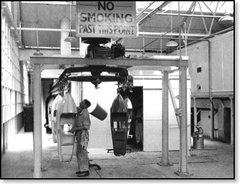
As stated earlier, the
Pathfinder were the first to go into production. The main
components were the body, trim, front and rear axles, pedal
assembles and wheels and tyres.
With the Pathfinder it only had two main pressings which were
supplied from Longbridge. The pressings were spot welded together
along with the facia and seat panels. As you can see from the
picture below, after having a pre-treatment via the Rotodip and
primer it passes to the paint spray booth. It would be hand sprayed
and as can be seen in the picture the bonnet travels separately.
They were available in Cream with Red Trim and also Wheels and
Grille, the other option was Red body with Beige/Tan Trim and
Silver/White wheels and grille.
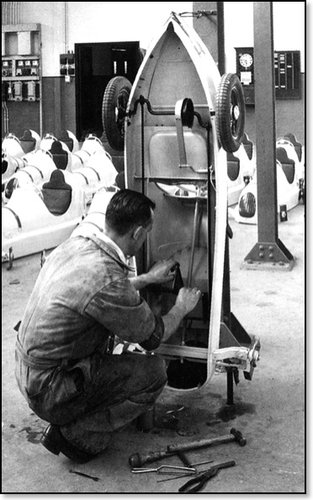
This shows assemble of the various items, including the parking brake which when operated pulls a band round a drum on the rear axle. The body is supported by a jig.
Welding line
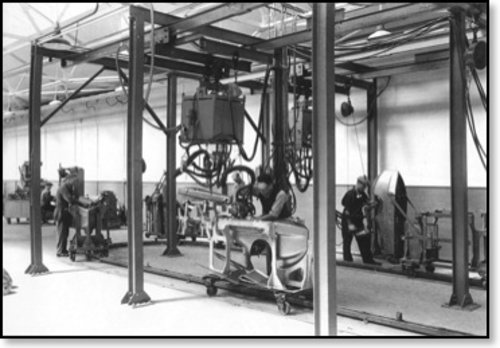
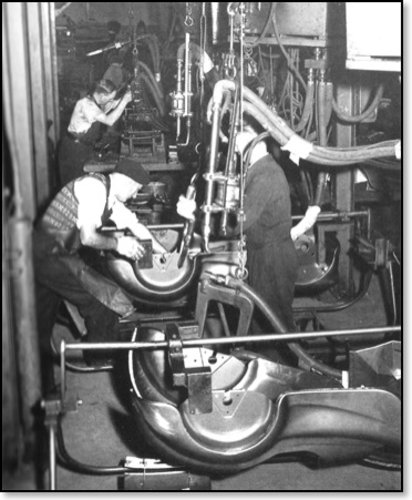
Assemble of the saloon on jigs which can be turned over to work on the underside
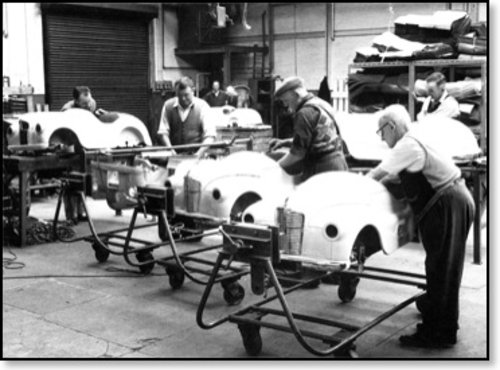
Pathfinders Waiting for Wheels
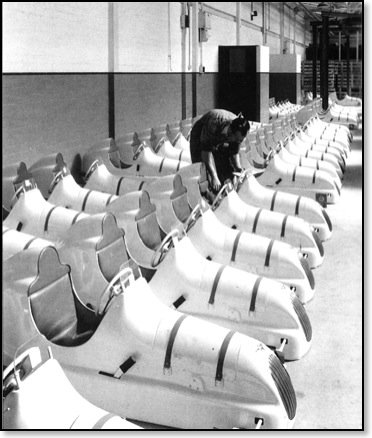
Ready To Ship
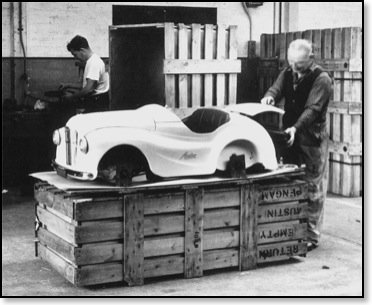
The End Of The Line
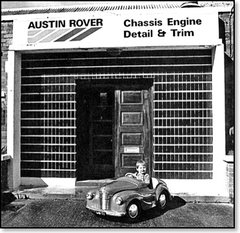
In 1971 it was
decided
to close down the factory because the glue that was used was effecting the
health of the workers.
On the 15th September 1971 the last of
the Joy Car were made all of them going to UK customers. At this
point the production total from 1955 to 1971 was 32,098, it is
believed that the figure from 1949 to 1955 was about 1,500 Joy
Roaster and over 3,100 Pathfinders.
Through The Years
The J40 was put to a multitude of uses both whilst still in production and long after.
Special J40 present to Prince Charles (1952)
Note the various extras : windscreen, wing mirrors, number plate, side lights & spot light.
Juvenile driver training throughout the world used the J40 as their main tool.
The Austin Pedal Car Club includes an interview wit Alfred Ash.
Joy Rides
Pedalmania Images
